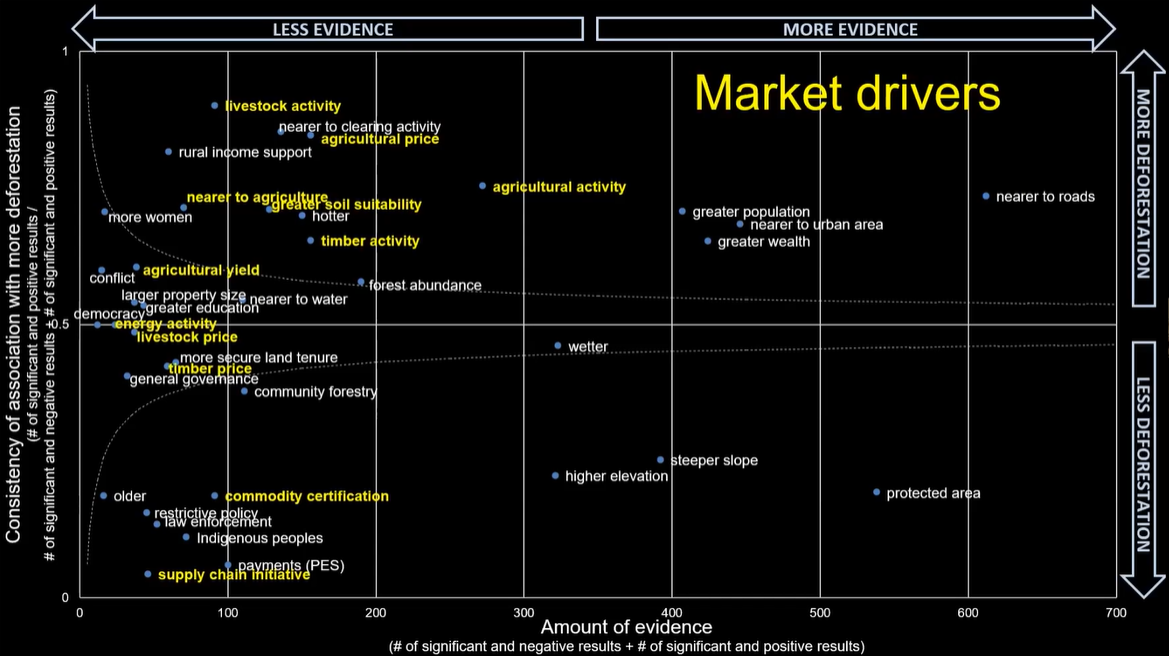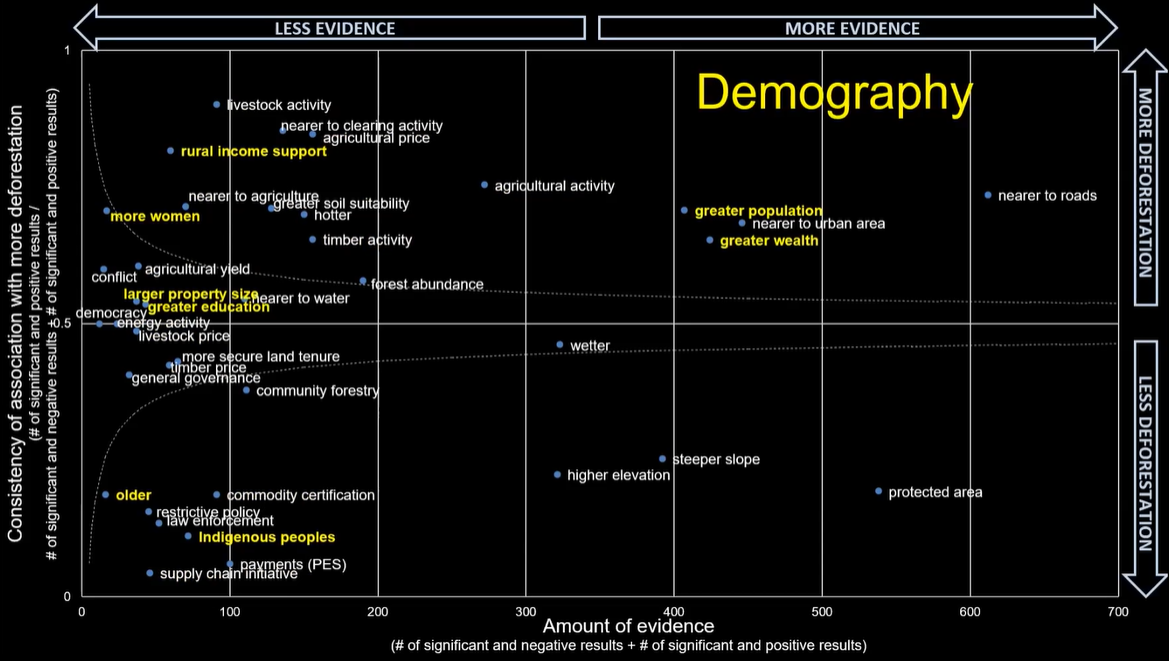
Meta Analysis of drivers of deforestation
A New Meta-Analysis of the Drivers of Deforestation
Deforestation is one of the main environmental problems facing the world today. The loss of tropical forests has serious consequences for biodiversity, climate, and human well-being. But what factors cause deforestation and how can it be stopped?
In a recent study published in the Review of Environmental Economics and Policy¹, the researchers Kalifi Ferretti-Gallon and Jonathan Busch conducted a comprehensive analysis of more than 15,000 data points from 320 published studies between 1996 and 2020, to identify the factors that are consistently associated with more deforestation, less deforestation, or neither.
🌐 Please check the johan Busch website
The Main Drivers of Deforestation
Their meta-analysis revealed that deforestation is driven mainly by agriculture and cattle ranching, road construction, urban expansion, and population growth. These factors increase the demand and access to land, reduce the opportunity cost of conserving forests, and facilitate the conversion of forests into other uses.
Agriculture and cattle ranching are the most important factors, as they account for 80% of global deforestation². The expansion of the agricultural frontier is due to both the production of food for local consumption and the production of commercial crops for export, such as soy, palm oil, and cocoa.
Road construction is another key factor, as it facilitates access to forest areas, both for legal and illegal purposes. Roads also attract other actors, such as settlers, loggers, and miners, who contribute to deforestation and forest degradation.
Urban expansion and population growth also exert pressure on forests, by increasing the demand for land, resources, and services. In addition, urbanization reduces the dependence of local populations on forests for their livelihood, which decreases their incentive to protect them.
The Main Factors that Halt Deforestation
Their meta-analysis also identified some factors that are associated with less deforestation or even with the increase of forest cover. These factors are steeper and less accessible terrain, stronger protections for parks and reserves, indigenous land management, product certification programs, and payments for ecosystem services.
Steeper and less accessible terrain reduces the profitability and feasibility of converting forests into other uses, by increasing the transportation and production costs. This makes forests more valuable in their natural state, as providers of ecosystem services.
Stronger protections for parks and reserves are essential to prevent deforestation, by establishing legal and physical boundaries for land use. However, these protections must be effective and enforced, which requires financial, human, and institutional resources.
Indigenous land management is another factor that contributes to forest conservation, by recognizing the rights and knowledge of local populations that depend on forests for their culture, identity, and livelihood. Indigenous peoples usually have a long-term vision and an ethic of care for forests, which is reflected in lower deforestation rates in their territories.
Product certification programs are voluntary initiatives that seek to promote more sustainable and responsible agricultural practices, by setting social and environmental standards for the production and trade of certain products. These programs can reduce deforestation by incentivizing producers to improve their land management, avoid forest conversion, and respect the rights of local communities.
Payments for ecosystem services are mechanisms that reward landowners or users for conserving or restoring forests, by recognizing the value of the benefits that forests provide to society, such as carbon sequestration, climate regulation, and water provision. These mechanisms can decrease deforestation by increasing the value of standing forests and compensating the opportunity cost of not converting them into other uses.
A Resource to Guide Models of Future Deforestation in projects
Their study is the first to conduct such a broad and rigorous meta-analysis on the drivers of deforestation. Below, I present a decision tree diagram to illustrate a decision-making process related to the topic. The diagram shows how an actor or landowner can choose between different land use options, taking into account the factors that drive or halt deforestation.
Key findings (Busch and Ferretti-Gallon)
Higher deforestation is consistently associated with:
- Greater accessibility (slope, elevation, roads, cities…)
- Greater economic returns (agriculture, livestock, timber…)
- Some demographic variables (non-Indigenous peoples, wealth…) but not others (education, gender…)
Lower deforestation is consistently associated with:
- Policies and institutions that directly influence allowable land-use activities (protected areas, payments, forest law enforcement…)
- But not policies and institutions that primarily seek other ends (land tenure security, conflict abatement, democracy…)
Note: The main findings of Busch and Ferretti-Gallon are very studied and what have less evidence. These factors vary by local conditions, governance, and policies.
🛣 Accessibility

- Nearer to Urban Areas: Urban sprawl leads to significant habitat loss. 🏗️
- Near to Roads: Improved access raises the vulnerability of forests. 🚜
- Near to Clearing Activities: Adjacent lands face higher deforestation rates. 🚧
📈 Market Drivers

- 🌾 More Deforestation:
- Agricultural and Livestock Activity: Major global deforestation drivers, with agriculture accounting for nearly 90% of forest loss.
- 🌱 Less Deforestation:
- Agricultural Yield: Higher yields can reduce or increase deforestation, depending on land use and profitability.
👨🌾 Demography

- 💵 More Deforestation:
- Rural Income Support: May inadvertently promote deforestation if linked to agricultural production.
- 🛡 Less Deforestation:
- Indigenous Peoples: Effective forest management by indigenous communities leads to lower deforestation rates.
🌲 Biophysical

- 🔥 More Deforestation:
- Hotter Climates: Wildfires and stressed ecosystems lead to more deforestation. 🌡️
- Forest Abundance: Valuable timber and land conversion pressures threaten forests. 🌳
- Proximity to Water: Water sources attract agriculture but also offer protection. 💧
- 🌧 Less Deforestation:
- Wetter Regions: Surprisingly, more rainfall can increase deforestation risks. ☔
- Steeper Slopes: Previously untouched, these areas are now prime targets. 🏔️
- Higher Elevations: Untouched forests at risk due to valuable resources. 🛤️
sequenceDiagram
participant U as Urban Expansion
participant R as Roads
participant A as Agriculture
participant L as Livestock
participant F as Forest Management
participant I as Indigenous Practices
Note over U,R: More Deforestation
U->>R: Encroaches on forests
R->>A: Provides access for agriculture
A->>L: Expands for crops and livestock
L->>F: Leads to forest loss
Note over F,I: Less Deforestation
F->>I: Sustainable practices
I->>F: Effective management reduces deforestation
SEED Database: A Resource for Understanding Deforestation
The SEED Database 📚 is an invaluable resource for researchers and policy analysts focused on the drivers of deforestation. This comprehensive database compiles a growing list of spatially explicit econometric studies of deforestation, all of which have been published in peer-reviewed academic journals.
As of July 2023, the SEED Database includes 320 studies dating from 1996 to 2019. It serves as a free, public, and periodically updated reference tool, aiding in the research and policy analysis of what drives deforestation and the measures effective in halting it.
🌐 The SEED Database is freely available for public use. To access the database file
Contributing to the SEED Database’s Impact
I encourage users of the SEED Database to contribute to its ongoing impact assessment. If you’re utilizing the database for your research or policy analysis, kindly send a brief email to jbusch@conservation.org. This will help us track the extent of its use and the impact it’s having on the global understanding of deforestation.
Navigating the Crossroads: Landholder Decisions on Deforestation (continued)
In the context of deforestation, the landholder paradigm involves a series of decisions based on economic, environmental, and legal factors. A landowner must weigh the potential profits from agricultural or cattle ranching activities against the value of conserving the forest. This includes considering market access, the physical characteristics of the land, and any legal protections or incentives for conservation.
graph TD A((Landholder paradigm)) --> B[Is agriculture or cattle ranching profitable?] B -->|Yes| C[Are there conditions to implement. i.e., roads, cities nearby, market?] B -->|No| D[Is there steep or inaccessible terrain?] C -->|Yes| E[Convert forest into agriculture or cattle ranching] C -->|No| F[Are there legal protections for the forest?] D -->|Yes| G[(Conserve the forest)] D -->|No| F F -->|Yes| H[Are the protections enforce by law or other institutions?] F -->|No| E H -->|Yes| I[Is there indigenous land management?] H -->|No| E I -->|Yes| J[Are there certification programs or payments for ecosystem services?] I -->|No| E J -->|Yes| G J -->|No| E
¹: Ferretti-Gallon, K. and Busch, J. (2024). What Drives Deforestation and What Stops It? A Meta-Analysis. Review of Environmental Economics and Policy, 8(1), 3-23. Article.
²: FAO (2020). The State of the World’s Forests 2020. Rome: Food and Agriculture Organization of the United Nations. Report.

